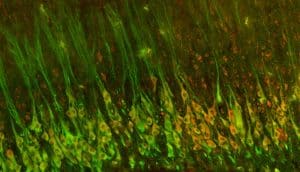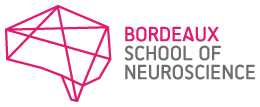The ability to move in an automatic or a goal-directed manner is a crucial function for many living organisms to survive and interact efficiently with their environments. Movements generation depend on the coordinated activity of motor centres that are distributed in the cortex, the basal ganglia, the cerebellum, and the brainstem but that, altogether, shape the descending motor commands sent to the spinal cord which will then execute the appropriate movements by controlling the activity of motoneurons. Any alteration in these systems and/or their interaction will impair the flow of information leading to disastrous motor disorders. In this CAJAL course, we will not only discuss the common organization of motor centres across species (from lamprey to primate) but also the neuronal mechanism and dynamics that underlie spontaneous and voluntary movements as well as how pathological alteration of these activities can lead to detrimental motor performances and disease state.
The goal of this CAJAL course is to instruct promising young neuroscientists to the advanced scientific concepts established in the field of motor control. We will present the latest discoveries that has been made in different species that shed light on how voluntary and goal-directed movements are generated. We will also describe the computational advances and analysis method that has pushed the limit of understanding movement generation.
Course directors
- Claire Wyart (Paris Brain Institute, France)
- Rune Berg (University of Copenhagen, Denmark)
- Nicolas Mallet (University of Bordeaux, France)
November 18 – 11:00am
Silvia Arber (Basel University, Switzerland)
Disentangling brainstem circuits for body movement.
November 19 – 9:00am
David McLean (University of Edinburgh, UK)
Sizing up principles of recruitment during locomotion in zebrafish.
November 20 – 9:00am
Samuel Sober (Emory University, USA)
Spiking codes for skilled motor control.
November 20 – 11:00am
Claire Wyart (Paris Brain Institute, France)
Optical innovations to probe connectivity and functions of sensorimotor circuits of the brainstem and spinal cord.
November 25 – 9:00am
Lora Sweeney (Institute of Science and Technology, Austria)
Evolution and development of swim versus limb motor circuits.
November 25 – 11:00am
Jonathan Whitlock (KISN, Norway)
Cortical integration of posture and active sensing in freely moving animals.
November 28 – 9:00am
Camille Jeunet (Bordeaux University, France)
BCI-based neurofeedback training procedures to restore or improve motor skills: a user-centred approach.
November 28 – 11:00am
Marie-Laure Welter (Paris Brain Institute, France)
Understanding Gait and Balance Disorders in Parkinson’s Disease: The Role of Basal Ganglia and Mesencephalic Locomotor Region Dysfunction.
November 29 – 9:00am
Nicolas Mallet (Bordeaux University, France)
Abnormal Network Dynamics in Basal ganglia circuits during Parkinsonism: Origins and pathophysiological insights.
December 2 – 9:00am
Rune Berg (University of Copenhagen, Denmark)
Control of movement by spinal circuitry: Model and population recordings.
December 2 – 11:00am
Gilad Silberberg (Karolinska Institute, Sweden)
Striatal circuits underlying sensorimotor functions.
December 3 – 9:00am
Ian Duguid (University of Edinburgh, UK)
Neural circuits for executing task-specific movements.
December 3 – 11:00am
Claire Meehan (University of Copenhagen, Denmark)
Probing intrinsic motoneurone excitability from mice to human.
December 5 – 11:00am
Ole Kiehn (University of Copenhagen, Denmark)
Unraveling Brainstem Circuits for Movement: Insights into Motor Control and Implications for Treatment of Movement Disorders.
December 6 – 9:00am
Joaquim Da Silva (Champalimaud CU, Portugal)
Direct and indirect pathway dynamics in dystonia.
Brice de la Crompe – Bordeaux University, France
Roberto de la Torre Martinez – Karolinska Institutet, Sweden
Amanda Jacob – Emory University, USA
Graziana Gatto – Emory University, USA
Kristen Frenzel– Emory University, USA
Xinyu Jia – Paris Brain Institute, France
Kevin Fidelin – Paris Brain Institute, France
Marco Romanoto – Paris Brain Institute, France
Anqi Zhou – Paris Brain Institute, France
Annaëlle Redon – Paris Brain Institute, France
Salif Komi – University of Copenhagen, Denmark
Emeline Pierrieau – CNRS, Bordeaux University, France
Lise Guilhemsang – CNRS, Bordeaux University
Marc Deffains – CNRS, Bordeaux University
Arthur Leblois – CNRS, Bordeaux University
Carmen Guerrero Marquez – CNRS, Bordeaux University
Florina Toma – Institute of Science and Technology, Austria
Filipa Barros – Champalimaud Centre, Portugal
Arthur Zhang – University of Edinburgh, UK
Constantinos Eleftheriou – University of Edinburgh, UK
The course will feature a series of honorary lectures by two of the 2022 Brain Prize winners, keynote lectures, and hands-on expert workshops covering experimental sessions and data analysis. Keynote lecturers will introduce their respective fields and share their latest exciting discoveries. Expert workshops, led by a select group of instructors, will provide in-depth, practical training.
Participants will receive hands-on training on state-of-the-art methods applied to the study of motor control in the field including motor tracking, optogenetics manipulation, calcium imaging, high-density electrophysiology recording and data analysis. Prior to the course, instructors will work closely with students to design and plan the detailed experiments conducted during the miniproject, ensuring a tailored and enriching learning experience. Each student will have the opportunity to present their research through short communications and a poster session. Additionally, students will showcase the results of their miniprojects conducted during the workshop.
Throughout the course, students will have numerous opportunities to build their scientific network and engage with course directors, keynote speakers, instructors, and peers.
The course will be an intensive 3-week theoretical and practical course with two main goals:
1) Teaching students the theoretical foundation of the techniques (in week 1 and 2).
2) Give them enough hands-on experience to create an experimental mini-project (week 1) that will be carried out (in weeks 2 and 3) so they can establish these methods when they get back to their labs.
– Stereotaxic surgery: viral vector injection, cranial windows, fiber optic, and miniscope implantation.
– In vivo one-color and dual-color calcium imaging
– High-density in vivo electrophysiological recordings using Neuropixel probes.
– Ex vivo and in vivo patch clamp recordings
– Building a brain-computer interface to decode movement
– Muscle fibers recordings using high-density Myomatrix arrays
– Using open-source tools to build motor behavioral apparatus.
– In vivo optogenetic manipulations during motor behavior
– Motor behavior in zebrafish larva and rodents
– Modelling the motor system & Data analysis

